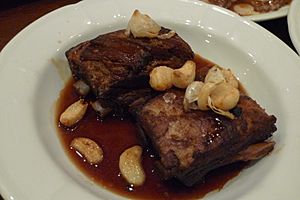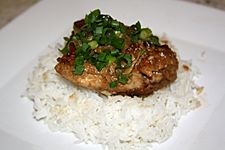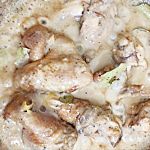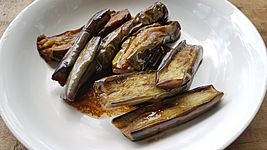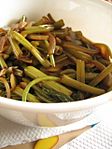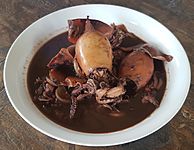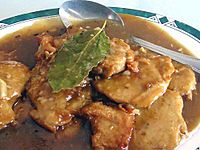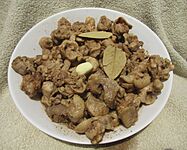Philippine adobo facts for kids
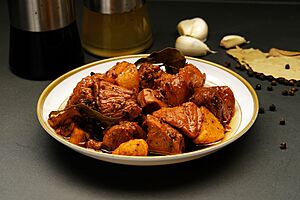
A bowl of pork adobo
|
|
| Course | Main course |
|---|---|
| Place of origin | Philippines |
| Associated national cuisine | Filipino cuisine |
| Serving temperature | Hot |
| Main ingredients | Meat (beef, chicken, pork), seafood, or vegetables; soy sauce, vinegar, cooking oil, garlic, black peppercorn, bay leaf |
| Variations | Some sugar for sweet-salty taste. Adobo with no broth, only coating on the chicken. |
| Similar dishes | Paksiw, kinilaw, estofadong baboy |
Philippine adobo is a very popular dish and cooking style from the Philippines. The word adobo comes from a Spanish word meaning "marinade" or "seasoning." In its basic form, meat, seafood, or vegetables are first lightly cooked in oil. Then, they are marinated and simmered in vinegar, soy sauce (or salt), and garlic. Many people consider adobo to be the unofficial national dish of the Philippines.
Contents
History of Adobo
The way Philippine adobo is cooked started in the Philippines a long time ago. Before the Spanish arrived, people in the Philippines already cooked their food with vinegar and salt. They did this to keep food fresh in the warm, tropical weather.
Vinegar is a very important ingredient in Filipino cooking. Traditional vinegars come from things like coconut, sugarcane, and nipa palm. These vinegars are made through a process called fermentation, which is also used to make alcoholic drinks.

There are four main traditional ways to cook with vinegar in the Philippines:
- Kinilaw: This is raw seafood mixed with vinegar and spices.
- Paksiw: This is meat cooked in a broth with vinegar and spices.
- Sangkutsá: This means pre-cooking meat in vinegar and spices.
- Adobo: This is a stew made with vinegar, garlic, salt or soy sauce, and other spices.
It is thought that paksiw, sangkutsá, and adobo all came from kinilaw. Other sour dishes like sinigang also exist, but they use fruits like calamansi or tamarind for sourness instead of vinegar.
When the Spanish Empire came to the Philippines in the late 1500s and early 1600s, they saw this way of cooking. The first time adobo was written down was in a dictionary from 1613. A Spanish missionary named Pedro de San Buenaventura called it adobo de los naturales, meaning "adobo of the native people."
The Spanish used the word adobo for any local dish that was marinated. But the idea of cooking adobo was already there long before the Spanish arrived in 1521. Over time, dishes cooked with vinegar, garlic, salt (and later soy sauce), and other spices became known only as adobo.
What is Philippine Adobo?
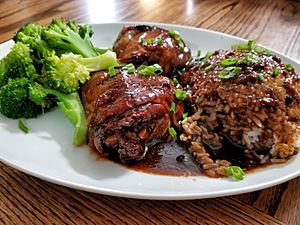
Even though Philippine adobo and Spanish adobo share a name, they are different. Philippine adobo uses ingredients that are common in Southeast Asia. These include vinegar (often from palm sap or sugarcane), soy sauce, black peppercorns, and bay leaves.
Unlike Spanish adobo, Philippine adobo does not traditionally use chili peppers, paprika, or tomatoes. They are similar because both use vinegar and garlic. Philippine adobo usually tastes salty and sour, and sometimes a little sweet. Spanish and Mexican adobos are often spicier.

Philippine adobo is more about a cooking method than a single recipe. It can be made with many different ingredients, not just meat. Most often, pork or chicken, or both, are cooked slowly. They are simmered in vinegar, crushed garlic, bay leaves, black peppercorns, and soy sauce. It is usually served with white rice. In the past, it was cooked in small clay pots. Today, people mostly use metal pots or woks.
There are many different ways to make adobo in the Philippines. The main ingredient is always vinegar. This can be coconut vinegar, rice vinegar, or sugarcane vinegar. Almost any other ingredient can be changed to fit what someone likes. Even people in the same family might cook adobo in different ways.
A less common version without soy sauce is called adobong puti ("white adobo"). It uses salt instead. This is different from adobong itim ("black adobo"), which uses soy sauce. Adobong puti is thought to be the most like the original adobo from before the Spanish arrived. It is similar to a dish called pinatisan, which uses fish sauce instead of vinegar.
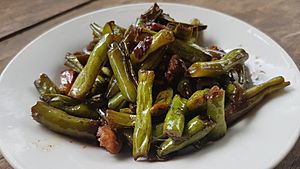
Adobong dilaw ("yellow adobo") uses kalawag (turmeric). This gives it a yellow color and a different taste. You can find this version in places like Batangas and the Visayas region.
The amount of soy sauce, bay leaves, garlic, or black pepper can change. Some people like their adobo dry, while others like it with a lot of sauce. Other ingredients can also be added, like chili peppers, bell peppers, onions, brown sugar, potatoes, or pineapple. Sometimes, it is even browned more in an oven or fried to make it crispy.
Adobo is a classic Filipino stew. It is eaten with rice every day and at special events. It is also a good food for travelers because it stays fresh for a long time without needing a refrigerator. This is because vinegar, one of its main ingredients, stops bacteria from growing.
Types of Adobo
The most common types of adobo are named after their main ingredients.
- Adobong manok uses chicken.
- Adobong baboy uses pork.
- Adobong baka (beef) and adobong manok (chicken) are popular among Muslim Filipinos because they follow halal food rules.
Other meats can also be used, like quail, duck, and goat. Seafood versions include fish, catfish, shrimp, and squid. There are also vegetarian options that use vegetables and fruits. These include water spinach, bamboo shoots, eggplant, banana flowers, and okra.
Even parts like liver, gizzard, heart, and neck from chicken can be cooked as adobo. Some more unusual versions include adobong sawâ (snake) and adobong palakâ (frog).
There are also different adobo styles depending on the region:
- In Bicol and Quezon, adobo often has coconut milk. This is called adobo sa gatâ.
- In Cavite, mashed pork liver is added.
- In Batangas and Laguna, turmeric is added, making it yellow. This is adobong dilaw.
Adobo has also become a favorite in modern Filipino cooking. Chefs create new versions, like "Japanese-style" pork adobo.
- Philippine ''adobo'' variants
-
Adobo sa gatâ (with coconut milk)
-
Adobong baboy (pork) with pineapple
-
Adobong kamaru
(mole crickets) -
Adobong kangkóng
(water spinach) -
Vegetarian adobo
-
Adobo made with chicken necks
Adobo Flavor in Other Foods
The taste of adobo is so popular that it's used in other foods too. Many Filipino snack products, like corn snacks, nuts, chips, and noodle soups, are sold as "adobo flavored."
Standardizing Adobo
In 2021, the Philippine government's Department of Trade and Industry (DTI) announced plans to create a standard recipe for popular Filipino dishes. Philippine adobo was the first dish they wanted to standardize. The goal is to make it easier to share these dishes around the world and keep their cultural identity.
A group of experts, including chefs and food writers, is working on this. They are using a cookbook called Kulinarya: A Guidebook to Philippine Cuisine as their main guide. Some people were worried about this plan, but the DTI explained that the standard recipe is not mandatory. It will just be a basic guide to help people know what an authentic Filipino adobo is, especially for international use.
Related pages
- Humba
- Pata tim
- Paksiw
- Kinilaw
- Dinuguan
- Estofadong baboy
- Ayam kecap - similarly styled dish from Indonesia and Malaysia
- Semur (Indonesian stew) - similarly styled dish from Indonesia
- Tsukudani - similar cooking technique from Japan
See also
 In Spanish: Adobo filipino para niños
In Spanish: Adobo filipino para niños


